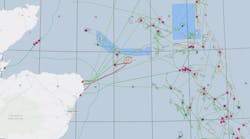Victor Schmidt
Houston
- Western Geophysical's 2,500 km 2D non-exclusive seismic survey offshore Nova Scotia, Canada. [42,230 bytes]
- A simulation of a Continuum Resources multi-sensory immersive environment that fuses legacy paper seismic data with an interpreters view of immersive environment navigational tools. [25,348 bytes]
East Canada deepwater survey ready
Western Geophysical announced the availability of Phase 1 of its offshore Nova Scotia 2D non-exclusive seismic survey in deepwater areas of eastern Canada. Approximately 2,500 km of long-offset data is available for immediate delivery. An additional 7,000 km of data is in processing.East Canada and East Russia 2D surveys underway
TGS-NOPEC began acquisition of two regional seismic surveys: one offshore eastern Canada and one off eastern Russia. The Canadian program, NS100, is a 60,000 km 2D survey located in the Scotian Basin off Nova Scotia. It will require three shooting seasons to complete. Around 7,000 km will be recorded this year.The Russia program, SOO98, is a 2D survey in the Sea of Okhotsk. About 10,000 km will be recorded in the remainder of 1998. This is the first phase of a five-year acquisition program covering three geological provinces: the Sakhalin, Khabarovsk, and Magadan basins. This program is being shot in cooperation with Dalmorneftegeophysika Trust (DMNG).
According to Mark Hamilton, CEO of TGS-NOPEC, "The projects in the Scotian Basin and the Sea of Okhotsk are the start of a long-term presence of TGS-NOPEC in two new and exciting exploration areas of the world."
Microseismic sensing
CGG Borehole Services Division, in partnership with CSM Associates, completed a large passive seismic survey in Valhall Field, Denmark sector of the North Sea. The SST-500 borehole seismic receiver was positioned 200 meters above the reservoir and remained in place collecting data for 60 days.Data were collected from six three-component geophones to provide information on structures within the reservoir. Valhall field is operated by Amoco Norway A/S.
Increasing density
TOTAL awarded a contract to CGG to re-master and compact 15,000 9-track and 21 track tapes plus 15,000 3480-type cartridges. The data will be reworked over the next year using the SEG RODE standard and will be compacted onto 3590 high-density cartridges. Associated printed documents will be scanned onto CD-ROM.Tectonic modeling
Dr. Eberhard Bodenschatz of Cornell University is producing excellent results using wax to mimic plate tectonic motions. Explained in a recent edition of The Economist, Dr Bodenschatz and his assistants have been able to model rift valleys, ridges, and rotating microplates similar to that off Easter Island in the Pacific. The features created depend on the speed of wax plate movement similar to earth plates.Grinding plates
The JOIDES Resolution completed Ocean Drilling Program Leg 180 in August. The main objective of the voyage was to gain a better understanding of how tectonic plates move by one another. The vessel drilled two holes reaching 900 meters into an active fault zone in the Woodlark Basin, 500 km east of Port Moresby, Papua New Guinea.Rocks and fluids were sampled vertically across the movement zone to learn how friction is reduced across such large faults. A four-meter section of fault gouge was collected. Fault gouge is a delicate clay like material formed from powdered rock.
In addition, sediment and rock samples were gathered horizontally to either side of the faulted seabed. Such samples provide information on age, former water depth, depositional environments, and sediment sources. This will allow reconstruction of the geologic history of the basin. The drilling samples will also be analyzed to identify the deep sub-floor biosphere. Bacteria remain present is sediment and rock samples from over 800 meters below the sea floor.
Virtual reality prominent at 1998 SEG conference
This year's SEG convention continued the exploration of a new interpretation environment - virtual reality (VR). This year, VR use expanded as companies demonstrated their specialties with special VR demos.- The Virtual Environment Technology Laboratory (VETL) showed the improvements made to their software package being developed in conjunction with the Oil & Gas Consortium. 3D seismic volumes from Stratfjord and Gullfaks fields were shown as was a 4D survey.
- Schlumberger Geco-Prakla gave a VR vessel tour of their seismic acquisition system showing the back deck of a vessel at work. The party chief controlled the streamers from the cyberstation. Viewers then experienced the streamers in the water while under tow.
- Bell Geospace presented a VR theater to fully explain its accelerometer system and the five independent gravity tensors that are acquired. Examples of seismic data with and without 3D-FTG were shown.
- T-Surf, the GOCAD company, demonstrated new software, GOCAD-VR, running in the SGI Reality Center and on a ImmersaDesktrademark from Pyramid Systems. Users were able to use GOCAD modeling functionalities: structural modeling, velocity model building, reservoir and stratigraphic modeling in the immersive environment.
- Continuum Systems demonstrated live collaborative networking that allowed explorationists to surround themselves with 3D data. Jeff Hume, CEO of Continuum Resources, said, "We believe that linking expert groups by means of low-cost networking and the use of collaborative immersion environments is a future path for leading edge E&P companies. Desktop immersive technologies will have a universal influence on the industry by fundamentally changing the way people work."
This will combine the skills of geodesy, navigation referencing, and directional drilling data analysis to provide a common referenced and quality-checked data set. "This will be the way oil companies analyze international leases sale data in the future," suggested Hume.
Copyright 1998 Oil & Gas Journal. All Rights Reserved.




